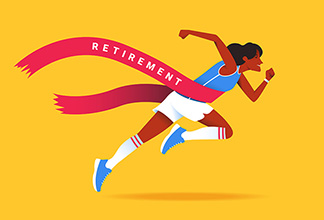How Personal Biases May Be Hurting Your Investing Decisions
Written by Rita Silvan
Published on August 29, 2017
minute read
Share:
Mattel has given Barbie's plastic companion, Ken, a millennial makeover. What's that? For one, some of the new Kens now sport a polarizing hairdo that caused a social media backlash: The man bun. Cue the kale chip and kombucha jokes.
"...we all have personal biases that influence our tastes in hairstyles, food, décor, pets and, yes, also our investment choices."
Why are we exploring the man-bun animosity? It's a good reminder that we all have personal biases that influence our tastes in hairstyles, food, décor, pets and, yes, also our investment choices. Sometimes these are conscious preferences, like crew cuts over man buns, but often our biases lurk just beyond our level of awareness and direct our behaviour more than we care to admit.
Many investors are familiar with "brand name" investing blind spots, like home bias, where we invest mostly in products and companies within our home country since they're the ones we're familiar with. But personal biases are unique to us, though, and this makes them harder to identify.
"Basing investment decisions on a colour palette may seem far-fetched, but a study this year from the University of Miami School of Business Administration found otherwise."
For example, picture a large, publicly traded company with a terrific balance sheet, excellent growth prospects and a generous dividend policy. What's not to love? How about the colour of ink they use when presenting their financial information?
Basing investment decisions on a colour palette may seem far-fetched, but a study this year from the University of Miami School of Business Administration found otherwise. Researchers found that when a firm uses the colour red instead of black to show past stock declines, investors expected continued declines, which prompted them to invest 24 per cent less in the firm's stock. In Western culture, red can often be associated with financial loss, which can make us biased against the colour. Years ago, when I attempted to sign a document with a red-inked pen, my stock broker at the time recoiled and handed me a pen with black ink instead. Needless to say, I now avoid signing documents in red.
What's in a name?
A study cited by The Wall Street Journal last year found that companies with "likeable" stock symbols enjoy higher valuations than those with less "likeable" or difficult to pronounce tickers symbols. In that study, researchers asked undergrad students to rate three-letter stock symbols from almost 2,000 publicly traded companies based on how much they liked them and how easy they were to say. Researchers from Emory University and the University of Kentucky also found that companies with short, snappy names attract more shareholders, generate more trading volume, and perform better on certain financial measures than those with multi-syllabic or hard-to-pronounce names.
It's personal
These examples show how strongly our emotionally based personal biases can affect our behaviour. And when those biases happen to be negative ones, their effects are stronger because they linger in our minds longer. (Read more about that in the Is Loss Aversion Hanging in Your Closet? feature.) A researcher from the University of Colorado released a study in late 2016 showing that, after a one-day market drop, journalists tended to use negative language about the stock market for four consecutive days — compared to only two days of positive language after a market rise.
"Using phrases such as 'I feel; I love; I hate' can alert us to how deeply our emotions are involved in decision-making."
How do we know if we're being affected by personal biases? According to Solve For Happy author Mo Gawdat, chief business officer at Google X, the search giant's innovation lab, one way is to pay attention to our language. Using phrases such as "I feel; I love; I hate" can alert us to how deeply our emotions are involved in decision-making.
In my own experience, if I only invested in companies and industries that I love, my portfolio would be heavily skewed toward luxury goods, fashion, beauty and high-end retailers. I'd hold few or no industrial, pharmaceutical or tech stocks, and the only commodities would likely be diamond and gold miners. It wouldn't exactly be considered a well-diversified portfolio.
Consequently, I'm what you might call a "flexitarian" investor. (In the diet world, flexitarians are mostly vegetarian, but sometimes eat meat.) With investing, there are some industries I will always avoid for personal reasons, regardless of how great an investment opportunity they may present. However, I'll still invest in companies whose products I may not love or use if I think it's a good investment for me.
It's natural to want to engage only with the things we love. But troubleshooting our blind spots can pay off. That Ken doll with the man bun may turn you off, but think about the payoff (read: joy) when the child who receives it thinks it's the "best gift ever." Could that be ample reward for overriding your personal bias?
Read more about biases in our Investing Blind Spots: More Than Meets The Eye feature.
RBC Direct Investing Inc. and Royal Bank of Canada are separate corporate entities which are affiliated. RBC Direct Investing Inc. is a wholly owned subsidiary of Royal Bank of Canada and is a Member of the Canadian Investment Regulatory Organization and the Canadian Investor Protection Fund. Royal Bank of Canada and certain of its issuers are related to RBC Direct Investing Inc. RBC Direct Investing Inc. does not provide investment advice or recommendations regarding the purchase or sale of any securities. Investors are responsible for their own investment decisions. RBC Direct Investing is a business name used by RBC Direct Investing Inc. ® / ™ Trademark(s) of Royal Bank of Canada. RBC and Royal Bank are registered trademarks of Royal Bank of Canada. Used under licence.
© Royal Bank of Canada 2025.
Any information, opinions or views provided in this document, including hyperlinks to the RBC Direct Investing Inc. website or the websites of its affiliates or third parties, are for your general information only, and are not intended to provide legal, investment, financial, accounting, tax or other professional advice. While information presented is believed to be factual and current, its accuracy is not guaranteed and it should not be regarded as a complete analysis of the subjects discussed. All expressions of opinion reflect the judgment of the author(s) as of the date of publication and are subject to change. No endorsement of any third parties or their advice, opinions, information, products or services is expressly given or implied by RBC Direct Investing Inc. or its affiliates. You should consult with your advisor before taking any action based upon the information contained in this document.
Furthermore, the products, services and securities referred to in this publication are only available in Canada and other jurisdictions where they may be legally offered for sale. Information available on the RBC Direct Investing website is intended for access by residents of Canada only, and should not be accessed from any jurisdiction outside Canada.
Explore More

Should I Invest or Pay Down My Mortgage?
Consider these four questions
minute read

As Many Head Back to the Office, Where Could Investors See Changes?
How returning to in-person work could affect a range of investments
minute read

Considering the FIRE Lifestyle? Here’s What Your Investments Might Look Like
We asked three people how they created financial independence and retired early
minute read
Inspired Investor brings you personal stories, timely information and expert insights to empower your investment decisions. Visit About Us to find out more.







